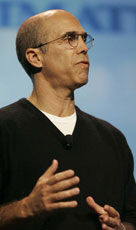|
When animated characters from Hollywood studios like DreamWorks
and Pixar Animation Studios take to theater screens around
the world, chances are graduates of Texas A&M University’s
visualization program have been hard at work behind the scenes.
The “viz” program, as it’s fondly known to
insiders, has been a fixture of the College of Architecture since
1989, and during that time, it has turned out about 200 graduates,
many of whom have worked on such hit movies as Finding Nemo,
Star Wars, Chronicles of Narnia, Toy Story, Jurassic Park, Shrek,
Ice Age, and Ice Age: The Meltdown. Just this month, Pixar Animation
Studios visited the program once again to recruit interns and
fulltime lighting directors, and DreamWorks praised its Texas
A&M viz alumni at the Houston press-only screening of its
latest feature, Over the Hedge, scheduled to open in theaters
in mid-May.
Chief executive officer of DreamWorks Animation SKG (DMA), Jeffrey
Katzenberg, says he’s “very aware of the viz program.”
“
I think the Texas A&M program is fantastic,” Katzenberg
adds. “My people are working on getting me to visit College
Station to meet the students myself.”
About 15 graduates of the program have worked or currently work
at DreamWorks.
Co-director of Over The Hedge, Tim Johnson, who also directed
Antz, DreamWorks’ first computer-animated feature, and
Sinbad: Legend of the Seven Seas, praises the exceptional work
and “fearless critical eye” of viz program graduate
Dave Walvoord, who currently works as a computer graphics supervisor
for DreamWorks.
“Dave is amazing,” Johnson says. “Over the Hedge presented
us with a real lighting challenge. I had a vision of moving beyond
the ‘painterly’ look and feel of many animated films
to achieve a more realistic photographic aesthetic. Dave took
up that challenge with an attitude of continually reaching higher
for better lighting effects.
“Dave’s experience with the viz program seems to have given
him a foot in both brains. He’s very creative, but he also
knows how to use the computer to relentlessly highlight the visual
information that matters while not obsessing about pixels that
aren’t crucial. He knows how to put the computer through
hoops, but he is also creative enough to know where to put those
hoops.”
Texas A&M’s legendary friendliness and spirit of cooperation
apparently transfers easily to animation work, as Dave’s
DreamWorks colleagues also sing his praises. For Over the Hedge,
Dave supervised employees like Igor Lodeiro, one of the first
Hispanic lighting technical directors at DreamWorks.
“Dave is the king,” Lodeiro says. “He is terrific.”
What kind of program turns out graduates that earn such accolades?
The Visualization Laboratory and Visualization Sciences academic
program were created in response to clear indications that digital
visualization was going to play an important role in digital
communication, say College of Architecture faculty members. The
resulting program combines intense study of theoretical foundation
courses focused on the science, math, technology, visual art
and aesthetic underpinnings of visualization, along with long
hours of hands-on work on the viz lab’s many computers.
“The advent of high-technology information, imaging and media
systems has fostered a modern renaissance in visualization,” notes
Frederic Parke, a professor in the viz program. “During
the European Renaissance, many of the period’s great painters
were not only artists, but also scientists, architects and engineers.”
Today’s visualizers need skills spanning these older disciplines
as well as several new ones, such as computer science, video
technology and psychology. In fact, the range of skills is so
broad that no one person can truly master them all, and the collaborative
team has replaced the solitary genius. Strong participants on
such teams need both specialty expertise and a broad background
to effectively collaborate with other team members.
At present, visualization studies in the College of Architecture
can be undertaken only at the graduate level, with students earning
either a master of science in visualization sciences or a visualization
specialty as part of a Ph.D. in Architecture. The masters program
is designed to help students develop the focused expertise and
broad foundation knowledge needed in this rapidly developing
field. The program’s core curriculum is intended to give
all students a basic grasp of the artistic, scientific, cognitive
and technical foundations of the discipline. Beyond this broad
training, the program requires students to develop a strong focus
area of advanced expertise, in which they are required to complete
a research thesis. The doctoral program, on the other hand, focuses
primarily on research and the development and dissemination of
new knowledge, preparing students for careers in research and
teaching.
Admission to the viz program is competitive, with students that
apply generally expected to have taken calculus and linear algebra
courses, to have proficiency in a high-level computer programming
language such as C++ or Java, and to have completed foundation
courses in artistic areas such as drawing, painting, sculpture,
design or photography. In addition, applicants must submit a
portfolio of their artistic work.
The campus and local communities look forward each year to Viz-a-GoGo,
an exhibition of current viz students’ work. This year’s
program, which features a collage of short animated films, is
scheduled for May 5 and 6 in Rudder Theatre at 7 p.m.
“Viz-a-GoGo is entirely student produced, and we all look forward
to it as a celebration of their accomplishments over the past
year and as an event that recharges our enthusiasm to pursue
even better work in the year to come,” says Parke.
| |

Jeffrey Katzenberg, chief executive officer
of DreamWorks Animation SKG, spoke highly of 'viz' students at
a recent press event for the studio's new "Over the Hedge" animated
feature.
|

